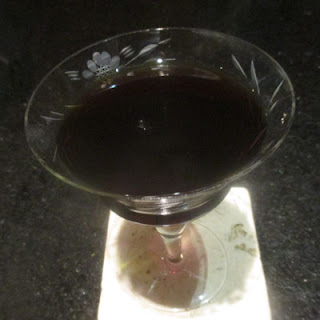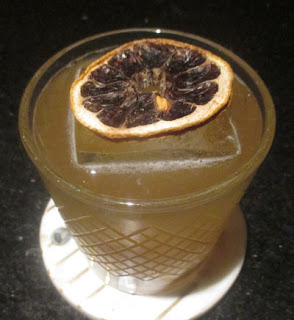First published on the USBG National blog in May 2017; slightly adapted version here.
A few years ago, I entered into a Friday night shift
knowing that we were down a server due to the new guy not finding our
place a fit and no-showing and as a result, the other bartender would be
working the private event in the other room. Tack on that it was the
first warm day that our patio was fully set up and there were plenty of
people milling around the neighborhood. So not only was the bar
half-staffed, but the restaurant itself was understaffed for the
evening.
I played in my head the advice that blogger/bartender Erik Ellestad
was given by his boss one night when the other person that was supposed
to be behind the stick could not make it in. The boss sagely guided Erik
with the mindset of, “You’ll probably go down in flames, but the most
important thing is to go down in flames gracefully.” This was relayed in
Erik’s discussion of William Boothby’s
Ten Commandments for Bartenders in the third commandment of “Always appear pleasant and obliging under all circumstances.”
It was not the first time that I have worked that bar half-staffed
including super busy nights such as when Valentine’s Day fell on a
Saturday this past February, and I have gotten through with the vast
majority of guests being understanding of the situation. The events set
up in the first paragraph were not one of them.
The following day, my boss came up to me and told me what a great job
I have been doing at the bar lately. I replied, “Save for my two star
Yelp review from yesterday.” I explained that I never consider myself
weeded if I am busy or in fact too busy. That is part of the job and
eventually the drinks will be made, the shift will end, and things will
reset; moreover, one elder server once told me, “If you ain’t sweating
Freddy, you ain’t earning.” Physically, I can only produce quality
drinks up to a certain rate which is also slowed down by guest
interactions; having a stack of drink tickets to make is just part of
the job. However, once there is anger from a guest, server, or manager
about the time it takes for a ticket to be fulfilled or an order taken,
then and only then do I feel weeded. It means that my triage system in
trying to make the most of the situation has failed. While sometimes
that is from a person who has been unfairly neglected, it is often
someone who wants slow night-level service at prime time.
In this case, four ladies sat at my bar, and I got them water and
menus immediately and went back to making tickets that were coming in
rapidly from both the patio and the 30 person open-bar event in the
other room that had only started moments ago. Soon, I took their drink
order and made their cocktails, and went back to making drinks and
trying to figure out where to transfer checks as the bar was the
waypoint for people waiting for patio tables to open up. Normally, both
the act of providing water and menus and the act of making the drinks
buys you a bit of time, respectively. Here though, while I was taking
the drink order of the people a few seats down, they started getting
needy about questions about food and placing an order. After the third
time explaining to them since they arrived that I would be there in a
moment, and not seeing a manager or server who could take their food
order that minute, I eventually snapped and scolded them with, “Look, I
am really busy and I will be there when I can.” It is not a tone I like
to use. It is a tone of defeat for a hospitality worker. The mystique
was broken. I was broken. The night felt broken to begin with, but in
reality, the rest of the evening went really well (considering). But for
those four guests, they left insulted.
While discussing the Yelp review with my boss, he first noted how
they mention that they were the only people at the bar and inside the
main room of the restaurant and all the action was outside, so they did
not understand why the bartender was so flustered. Besides the inside
guests, they did not even acknowledge the three guests to their right.
My boss did provide me pointers on phrases to use to communicate to
guests and keep the mystique. For example, never say "a minute" or any
distinct time frame other than "a moment." Perhaps tell them that they
are next after these guests or these two parties, but do not make a time
frame more specific than that.
Some other advice that has helped me is to ask for assistance. Not in
a vague way, but asking someone to take a food order, clear plates, or
other task. This sometimes can be more difficult; when everyone else is
slammed, there is less of a team environment at the establishment. But
your very moment of need might be at a less high-pressured moment for
someone else. Also, try to keep management abreast of your needs and
report incidents as they happen so complaints in person or online are
not so much of a surprise. In my above story, I forewarned them that it
was the makings of a bad Yelp review, and I was not wrong.
In the stress of it, make note of what is wasting your time the most,
such as the way the well was set-up, or how the host was taking bar
guests and sitting them at tables without communicating where the guests
went so I could forward the financials. Figure out with the bar staff
and the management later how to make these things more streamlined.
Also, when things subside for a moment, take a minute to drink water,
tie your shoe, and clean up your station – things that will allow you to
be in it for the long haul that night.
In terms of mental focus, remember that every shift ends and the
workday resets. This was not the case when I worked in business where
the stress carried over into the next day. Know the rhythms of your bar
and restaurant of when things will be at their peak and how long that
peak usually lasts, for it will help set a better idea of when things
will lighten up as opposed to just counting the hours to the end of the
night. True, every night is a bit different, but over time, it is
possible to gain a good understanding of the range of how things
generally are.
I wish that I could advise to never be unpleasant, but as I have
described already, it is not always possible in every situation. We are
human and hospitality is a two-way street, even if it ought to seem like
a one-way one. With co-workers, remember to apologize. Feelings get
trampled in the heat of the moment, and always take the time to try to
mend it later. Experienced restaurant workers know what it is like, and
just acknowledging their feelings will generally make them relate,
forgive, and forget. Apologizing to the guest is not always possible if
they have stormed off, but there are ways of patching it up if they stay
past the high volume moments. Some of the best hospitality moments that
I have observed or participated in have come in the rescue of what was
heading towards a bad dining or drinking experience.
I have heard some advice to take a shot to calm the nerves and keep
working. I cannot speak for what works for others, but I feel that I am
most on top of my game when the drink in my hand is coffee. However,
when it gets really busy, that coffee is room temperature and hours old
by the time I take another sip, but it seems like such a treat
regardless.
The saying, “Be like a duck. Stay calm on the surface but paddle like
hell underneath” is a good slogan to remember. However, bartenders have
the problem of always being in front of their guests as well as in
front of the servers at the pass looking for their tickets being
fulfilled. Eyes are always on us looking for the answers to their needs
when things get busy. Adapting a zen-like demeanor and pleasantly
working at full capacity is the goal – do your best to go down in flames
as gracefully as possible on those nights. Failing to maintain that
100% is just reality. Do not blame the circumstances, but understand
them to put things in perspective and learn from them.
Finally, learn to relish the slower shifts even if they are not the
ones that pay the rent. The slow times are when you can feel great about
yourself as a hospitalitarian and free yourself of guilt for any
slights and slips during the busier nights. Indeed, in the past, my Sunday night
shifts after a busy weekend are some of my favorites in regards to guest
treatment and interactions with my co-workers. And yes, on those
nights, I can sip my coffee when it is still warm.































 The 2017 collection of 855 drink recipes, bartender tributes, and essays on hospitality from CocktailVirgin's Frederic Yarm. Available at
The 2017 collection of 855 drink recipes, bartender tributes, and essays on hospitality from CocktailVirgin's Frederic Yarm. Available at  The 2012 collection of 505 drink recipes, techniques, and Boston bar recommendations from Frederic Yarm. Available at
The 2012 collection of 505 drink recipes, techniques, and Boston bar recommendations from Frederic Yarm. Available at 




